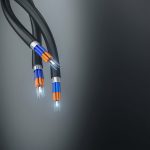Nokia Demo First UK Trial of 25G PON for 5G Backhaul with CityFibre

Nokia and CityFibre have teamed up in Glasgow (Scotland) to conduct the UK’s first successful demonstration of a trial that used their full fibre 25G PON kit to fuel backhaul capacity for a 5G mobile (mobile broadband) network, which was used for a holographic call between buildings, teleoperation of a robotic arm and 8K video streaming.
We first covered the emergence of symmetric speed 25G PON technology in November last year (here), which is often regarded as the next step in Passive Optical Network (PON) evolution. Back then Nokia said that the new technology can “co-exist with GPON and XGS-PON on the same infrastructure [this requires no changes to the outside plant], allowing [ISPs] to add 25Gbps in overlay without disrupting existing customer services.”
Since then, Openreach has also conducted trials of this and shown that it does indeed have the ability to push download speeds of 25Gbps (Gigabits per second) over a single optical fibre (here), which in the future could help to support much faster speeds via Fibre-to-the-Premises (FTTP) broadband networks and other services.
Advertisement
Now CityFibre and Nokia have joined forces to conduct their own trial of 25G PON at the University of Glasglow (Scotland 5G Centre), which ran on the exact same fibre as their existing XGS-PON powered service (i.e. co-existence of multiple wavelengths on the PON) and helped to provide the backhaul for an ultra low latency 5G mobile network.
The successful test, carried out on 18th November 2021, used the network for a series of simulations including a holographic call between campus buildings, teleoperation of a robotic arm (pictured) and 8K video streaming.
Matt Yarwood, Network Architect at CityFibre, said:
“Nokia and the University of Glasgow 5G Centre have demonstrated the ease at which CityFibre’s Full Fibre passive optical networks can scale and evolve to meet tomorrow’s technology requirements. This better-by-design approach to digital infrastructure means we can accommodate the low latency backhaul requirements of 4G & 5G mobile operators and enable the development of new and exciting high-bandwidth applications.”
Phil Siveter, CEO of Nokia UK, said:
“This trial has been hugely encouraging. 25G PON will be a game-changer with mission-critical 5G networks increasingly requiring more redundancy. And it’s proven it can be run on exactly the same fiber running XGS-PON traffic.”
Take note that, dependent on the optics chosen, 25G PON can support symmetrical bitrates (25Gbps in downstream and 25Gps in upstream) and asymmetrical bitrates (25/10). Naturally, CityFibre, much like Openreach before it, are keeping a close eye on emerging technologies for when the time comes to upgrade.
CityFibre are of course in the process of investing £4bn to ensure that 8 million premises – across 285 cities, towns and villages (c.30% of the UK) – are covered by their FTTP broadband network by the end of 2025 (here). So far, they’ve already completed their initial rollout to 1 million premises.
Advertisement
Mark is a professional technology writer, IT consultant and computer engineer from Dorset (England), he also founded ISPreview in 1999 and enjoys analysing the latest telecoms and broadband developments. Find me on X (Twitter), Mastodon, Facebook, BlueSky, Threads.net and Linkedin.
« Survey Claims 834k UK Homes Switched ISP for the First Time in 2021
Business UK ISP Onecom Acquires Rival Russell Telecom »






















































A matter of time when vendors start to roll out early doors silicon for 50 GPON – now that the standard has been ratified by the ITU.T earlier this year
25 GPON may be overlooked commercially, as not being a big enough step up beyond the current XGS-PON.
Yes, it is more likely to be 50G-PON that will take over from XGS-PON, when that time comes. Currently, 25GS-PON targets business and backhaul. Time will tell, if it will be used for residential customers.
With DWDM you can put 100G symmetrical down a single Fibre, alongside PON, as long as you choose your wavelengths carefully; Also, It wouldn’t have to be Nokia kit used, you could use bespoke solutions from any DWDM manufacturer, tapping in through an optical splitter. I don’t see the point in testing 25 GPON if it’s already been tested and proved to work previously.This has a feel of CityFibre and Nokia hooking up for some advertising and marketing hype.
It is still very new, and an operator will always trial and evaluate a new technology before deploying it.
What are you talking about, what did you supposedly done was telecom enginner? You can put a lot more with dwdm, PON is different technology that can be used with splitters, doesn’t require whole DWDM kit on other side. You can put 400g over two strands of fiber but this is expensive, that’s why other technologies are used.
The point being that 5G front, mid and backhaul traffic can utilise the existing widely deployed PON infrastructure without having to install dedicated and expensive DWDM links. Also 25G can happily coexist on the same fibre with GPON and XGS-PON.
The residential density of 5G RAN lends itself perfectly as a use case to utilise Broadband Base Unit traffic over the PON towards the RAN.
If you could provide a use case where using DWDM equipment either side, choosing wavelengths carefully, makes more sense than using a fibre pair and off the shelf optics with no DWDM that’d be great.
This technology is good as it just slots in and doesn’t require a fibre per base station. A single fibre and port at the POP can handle up to 32 base stations which works great – load shifts between base stations as the people using those stations shift physically so a way better use of capacity than providing point to point to each.